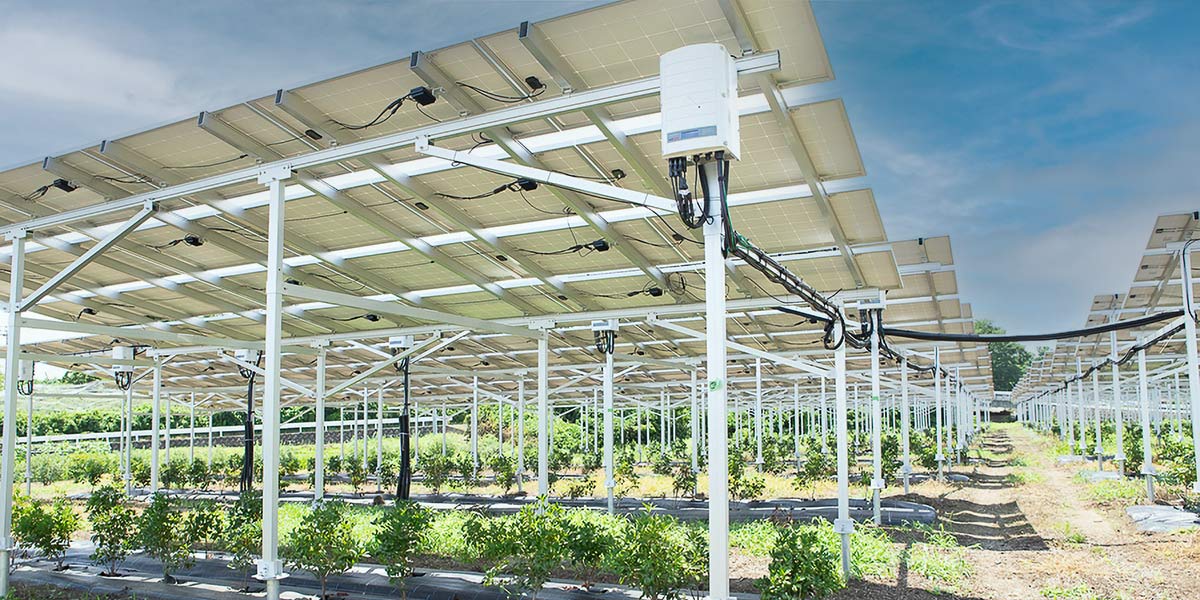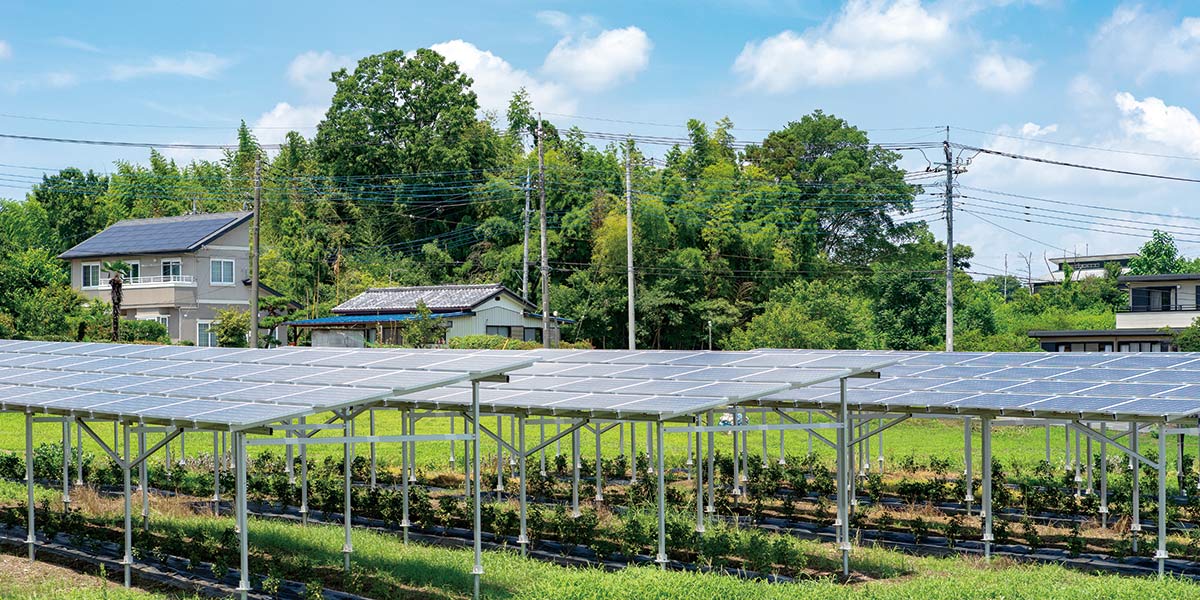5 Reasons Why Agri-PV Means Important Growth for Farmers
Smart energy used in agricultural environments (also known as agri-PV or agrivoltaics) is giving farmers more control over their profitability and their energy future. Reducing operational costs, increasing crop yields and adding new revenue streams are just some of the big benefits solar can bring to commercial farming.
The terms “agriovoltaics” and “dual use farming” have become practically synonymous. Dual-use farming occurs when elevated PV systems are installed over crops – also referred to as co-locating. Your solar panels effectively do double duty – producing free electricity while providing optimal sunshine and shade for the crops below, reducing heat stress and water loss.

Let’s start with a textbook definition
According to the Institute of Solar Research, “The dual use of land for food production and electricity generation is a promising concept. It can help meet the world's growing demand for food and electricity in the face of increasing land scarcity.”
Here are some of the top reasons why agrivoltaics is becoming a key gamechanger in the global green energy transition.
Reason 1 – Putting the Sun to Work for You
While sun in the right doses is critical for photosynthesis to grow healthy crops, the ability to manage just how much sun your crops receive can be even healthier. As each crop has its individual light compensation point and different shade tolerance, the ability to provide the right amount of shade or light to each of your crops can have a significant impact on growth and quality. According to one recent study on a Kenyan farm, crops such as cabbage, lettuce, and eggplant grew up to a third larger under solar panels than those farmed in direct sunlight, while reducing the farm’s energy costs by 50%.
It’s important to note that not all solar solutions can deliver light and shade management. For best results of both crop protection and solar production, the choice of solar module can make a difference. More importantly, AI-driven solar trackers, like SolarGik, can constantly adjust the angle of the solar modules to balance the needs of the specific crops and solar production according to time, weather and season.
With climate change, the incidence of crop damage caused by extreme weather events is growing annually. Solar modules installed over your crops can reduce the impact of hail, wind, heavy rain, and intense direct sunlight. This has particular benefits for the more sensitive crops and for orchards, where hail can have disastrous effects on the yield.
Climate change has also been responsible for reduced rainfall in many locations and severe water shortages. The partial shading that occurs when PV modules are elevated above your crops can reduce water evaporation and irrigation requirements. Studies show that agri-PV systems with variable tilt features maintain moisture uniformly in the soil. In arid regions, any solution that can improve soil moisture is a genuine game changer.
Reason 2 – Bigger and better crop yields
With agri-PV’s ability to control some of the variables that impact crops, it stands to reason you should expect improvements in crop yields. A number of studies have already weighed in with promising statistics.
A 2018 study published in “Applied Energy” used a 40-year data set of weather conditions in a specific area of Northern Italy to create a simulation of crop yield under agri-PV with a solar tracking system. They plugged in data of a control site of similar crops in full sunlight, with the same weather conditions. The study concluded that, “average grain yield was higher and more stable under agrivoltaic than under full light.” They also noted that the advantage of growing maize in the shade of PV increased proportionally to drought stress and concluded that an additional benefit of agrivoltaic systems would be increasing crop resilience to climate change.
A summary of several studies conducted on a variety of agri-PV sites around the world reports excellent yield improvements for certain kinds of crops - specifically a type of pepper that resulted in a 150% crop increase, and cherry tomatoes that marked a 90% increased yield. It’s important to note that the exact effects of the agri-PV system on crop production may vary due to air temperature, moisture, location and other factors.
In a study conducted by researchers from the University of Arizona, it was concluded that crops growing under the shade of solar panels could yield two or three times more fruit and vegetables, citing apples, pears, berries, and grapes as good candidates.
Reason 3 – More efficient land use
The world’s available arable land is being threatened by climate change and environmental degradation. The Executive Secretary of the United Nations Convention to Combat Desertification, Ibrahim Thiaw, reported in 2019 that, “Simply put, land feeds us all,” and that 25 per cent of the world’s land has been rendered unusable, threatening everything we eat, drink and breathe.”
With fertile land at a premium, farmers need to make an informed decision about how best to utilize their greatest asset. Agri-PV further can increase farmland value and may prove to be a key solution to feeding a growing population with decreasing resources.
In addition to installing their own PV systems over crops, farmers have successfully formed alliances with adjacent PV plants to allow their livestock to graze comfortably near the sites, under or between the solar panels. In one example, this collaboration has resulted in about 75% lower mowing costs and reduced mowing damage to the installation. It also provided farmers with an additional revenue stream as they are paid to allow their livestock to graze.
Because farmland is often not uniform, it is important to choose a solar system that can manage uneven terrain while maintaining high yields.

Reason 4 – Free energy for agricultural operations and an additional revenue stream
Farmers can use the electricity generated by their own PV system to power their farming operations, reducing their dependence on increasingly expensive grid electricity. Some of the most energy-intensive machinery that can be powered by solar includes irrigation, heating and cooling and lighting which can lead to significant cost savings over time.
Germany’s Fraunhofer Institute for Solar Energy Systems ISE, reports that in 2021, 14 GW of power was generated in dual-use systems which is enough to power 2 million households annually. Depending on the region, farmers can sell electricity generated by the PV system back to the local utility, providing an additional source of revenue.
Governments are providing financial incentives. regulating carbon production and providing financial benefits to businesses that comply and fining those that don’t. Green tax credits and other benefits may also be available for farmers, depending on the region.
Reason 5 – Increasing biodiversity and reducing carbon footprint
Researchers at Oregon State College discovered that areas beneath solar panels had their own microclimate with 328% more water efficiency and higher levels of soil moisture throughout the summer. That led to twice as much grass under the arrays as in the unshaded areas. They also experienced a 90% increase in late-season plant mass in areas under PV panels.
In other instances, agri-PV is used to create habitats that attract pollinators such as butterflies and bees, or for agrisolar beekeeping. This is a popular application with more than 1 GW of such sites already installed.
Choosing the right equipment for agrivioltaics - SolarEdge
SolarEdge agri-PV solutions with SolarGik trackers are optimized solutions for dual-use farming.
SolarEdge PV systems maximize both the crop harvest and the solar energy production with Module Level Power Electronics-based (MLPE). MLPE technology, enabled with SolarEdge Power Optimizers, enables each module to produce at its maximum energy level independently, regardless of module orientation or shade /dirt exposure. This is key to success in agri-PV installations as the additional energy produced is often significant to the bottom line of the project.




Add new comment
Comments